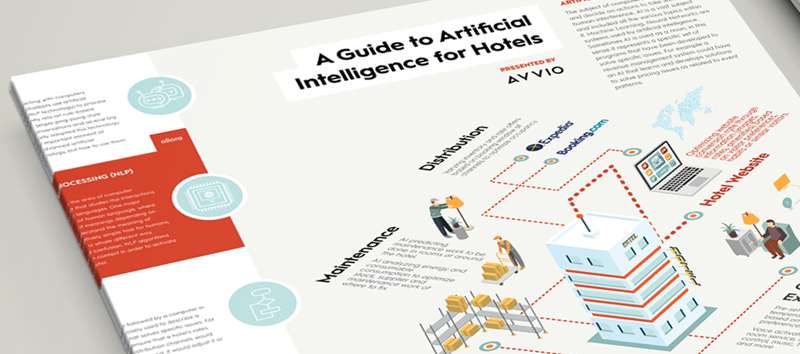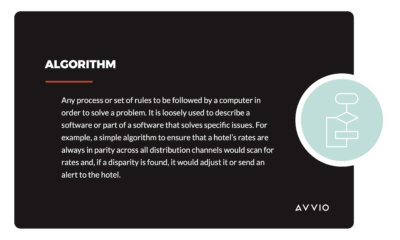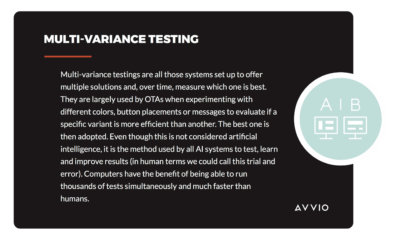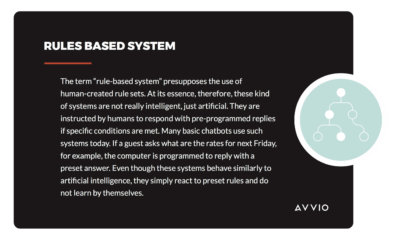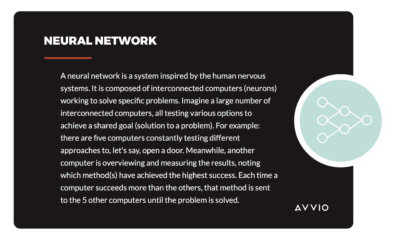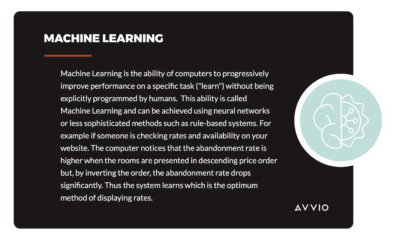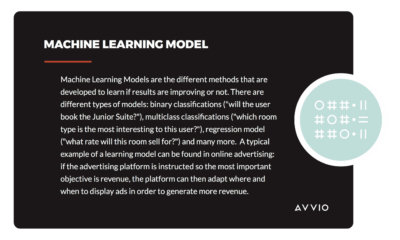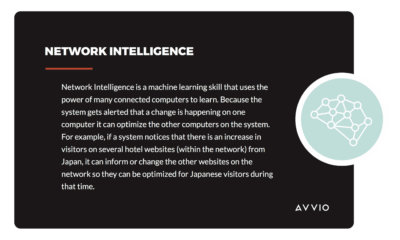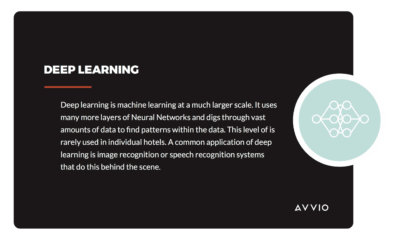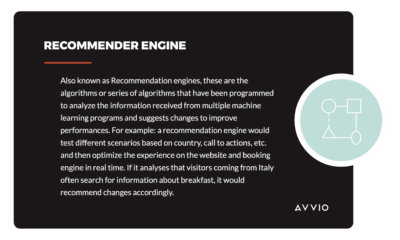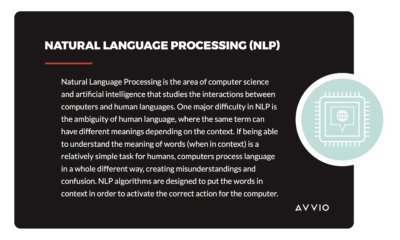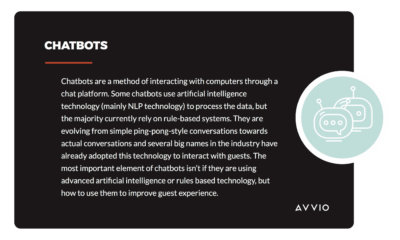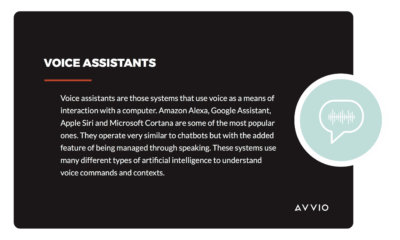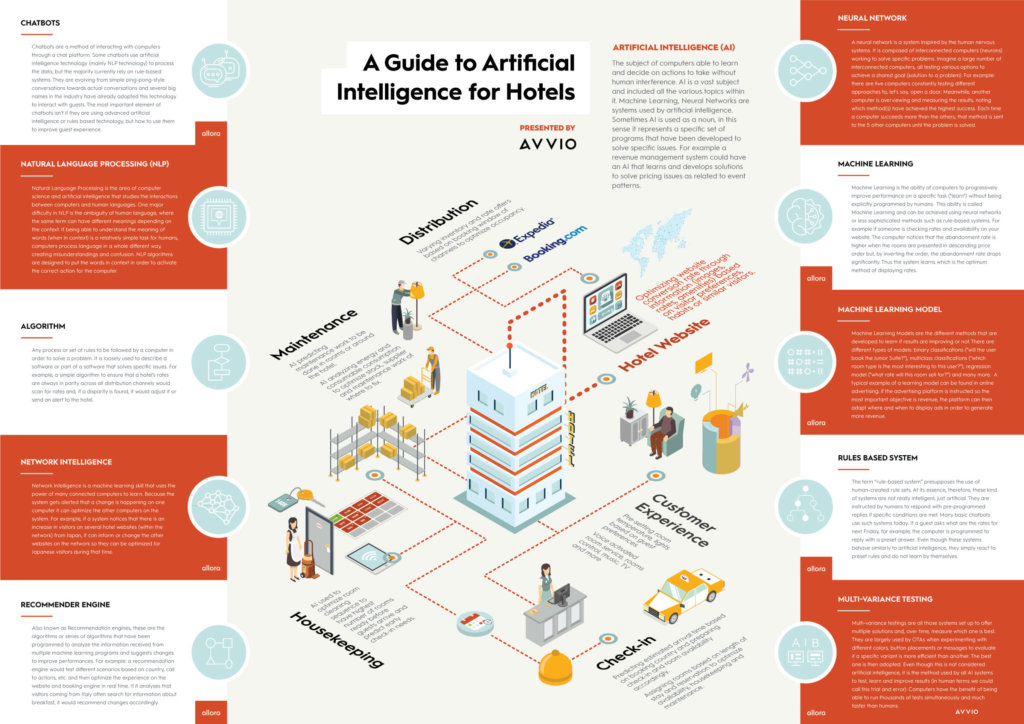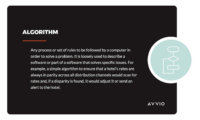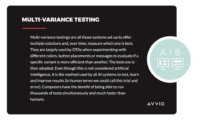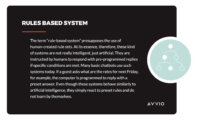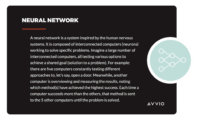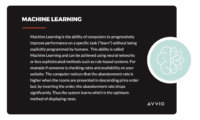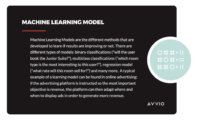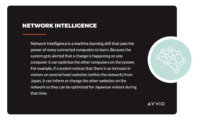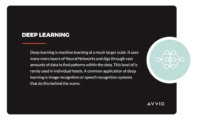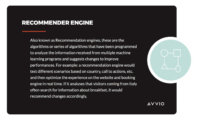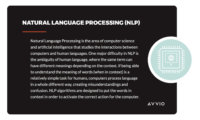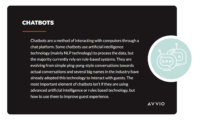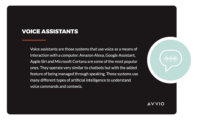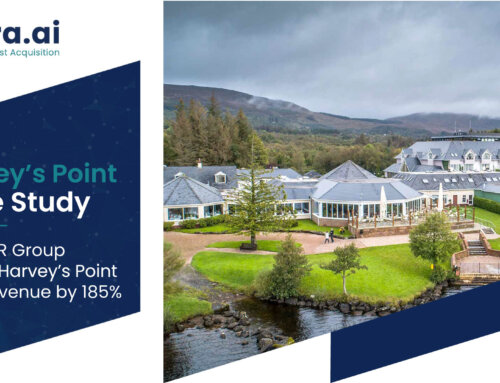Artificial Intelligence (AI) Without the Technicalities
The problem with all new hotel technology, unfortunately, is that innovation gets turned into buzzwords quickly, usually in order to sell more products and services. Even worse, all these buzzwords are thrown into the same marketing pot, creating a vast confusion that only “experts” can understand.
With this article and accompanying infographic, we will demystify this subject of artificial intelligence (AI) and explain, in plain terms, what it is and what it means for hotels. This guide was created with the intention of clarifying the most important terms and concepts related to artificial intelligence and shedding some light on what AI really means for hotels, without technicalities and by providing easy-to-understand industry examples.
Note: This article is also available as a PDF to download here.
Using AI in Hotels, Assisting Staff and Guests
“What is a lobby boy? A lobby boy is completely invisible, yet always in sight. A lobby boy remembers what people hate. A lobby boy anticipates the client’s needs before the needs are needed”. This quote, from the critically acclaimed movie by Wes Anderson, The Grand Budapest Hotel, summarises what the human touch of (great) hotels actually means: staff invisibility and anticipation of guest’s needs. Ultimately this is what makes a good hotel great. And this is, de facto, what hospitality is all about.
But, as the volume of guests increases and the hotels get bigger, the notion of hospitality tends to become more industrialised and less personal, until it eventually loses all of its humanity and personality. In mega hotels and big chains, that unique human touch becomes an expensive commodity, and a one-size-fits-all approach may end up being the prevalent trend. But here is where, AI kicks in: If a hotel struggles to offer their guests a tailor-made experience, then management only needs to make its human touch more scalable.
Imagine, for example, a system alerting the hotel about the expected arrival time of a guest. The guest’s room should be ready before a specific time the Valet (knowing the car’s registration) could greet the guest by name, and the front desk would have all the elements to start a memorable and highly personalized check-in experience. Or if a guest is arriving late in the evening, the system would email the guest the room-service menu in case the guest wants to order something to eat upon arrival. These are perfect examples of how a great first impression can really win a customer over.
This, tailored experiences based on known data, is what a hotel website should also be focused on, as it is often the first point of contact with the guest.
This is not deep AI, but merely examples of how a handful of smaller improvements can help transform an acceptable guest experience into a great one.
What Happens to Humans and Jobs When AI Arrives?
In the publication “The Future of Employment: How susceptible are jobs to computerization?”, authors Michael Osborne and Carl Benedikt Frey estimate 47% of U.S. jobs are at “high risk” of potential automation. The fact is, any repetitive job is at risk of being replaced by machines.
Even though this trend is unlikely to impact the hospitality industry in the same way, it is undeniable that replacing human interaction where it does not add any value, and increasing it where it does, is the optimum use of AI.
Hoteliers should let computers analyze trends and patterns in guest behavior, so their staff can focus on the personal interactions, without the need to browse through tons of emails just to remember if Mr. Smith prefers a poolside or a streetside room.
Humans should focus on what they do best and let computers do what they do best. What about having hotel staff help guests to their rooms and checking up on a personal level how the guest is doing and using that to optimize the stay, rather than entering addresses and checking credit cards and scanning passports.
It is not a question of machines replacing humans (and, to be fair, this hasn’t been the case, as technology has increased rather than reduced total employment over the years), but rather machines working together with humans, on the fields they are respectively best at.
AI Researcher François Chollet once wrote that “the intelligence of an octopus is specialized in the problem of being an octopus. The intelligence of a human is specialized in the problem of being human”. And we could not agree more. For example, Avvio’s first AI development was to analyze user behavior on hotel websites, in real-time, in order to optimize the design and information and thus enhance the user experience. No human could do that, but the result is a more personal experience for visitors.
Removing the Friction in Guest Experience
What hoteliers tend to forget is that, even though there are surely a lot of things that guests enjoy doing when traveling, such as relaxing by the pool or having a drink at the bar, there are others they do not.
Checking in after a long flight or checking out when one is already late for a meeting, for example, are definitely part of the latter. The intangible, yet precious human touch, in these cases, is close to irrelevant: guests just want to get to their room (or out of it) as soon as possible.
Joseph Weizenbaum, German-American Professor at MIT, wrote that AI “cannot, by definition, successfully simulate genuine human empathy” and it is true, but a good part of the actions guests perform when in the hotel need no human empathy.
The bottom line is if a computer can do it, let it. Use your staff to focus on situations where the personal interaction is critical. For example, hotels typically sit on large amounts of data, and it would be cost prohibitive to have people crunching the data to analyze trends, yet machines do that in seconds. Why waste human potential on this kind of task?
Artificial Intelligence in Hotels
While a lot of the current uses for artificial intelligence in the hospitality industry is related to revenue management, marketing, and advertising, there are many other possible applications. It can be applied to optimize housekeeping, by approximating early check-in or late check-out needs or predict maintenance work to be done in rooms. Little things, such as estimating when to refill soaps, can reduce time spent by staff knocking on doors and improve the guest experience. Not to mention, optimize inventory management.
Customer experience can benefit from AI as well: think about pre-set room temperature based on guest preferences or voice-activated room service, rooms control, music, and TV. AI could predict estimated guests arrival time based on their nationality, and Housekeeping can prioritize room availability accordingly.
When Avvio added AI to hotel websites and booking engines, to optimize guest experience and conversion rate, we saw how an accumulation of many tiny improvements resulted in increased efficiency and revenue for hotels. Artificial Intelligence in hotels isn’t about one “killer app” that changes everything. Much like hotels themselves, there are dozens, if not hundreds, of smaller improvements that make the experience better.
The Basics You Need to Know
We’ve sat down as a team at Avvio to work out easily understandable definitions for all the AI terms that are often thrown around by professionals, in articles or promotional materials. We have done our best to keep the definitions simple while dealing with a relatively complex subject. These are the fruit of many experts at the company who work with AI in hospitality every day.
AI is a broad subject, in terms of technologies, it is best viewed as a category comprising many branches of technology. The term tends to be defined using complex words which are themselves unclear and are often branches within the broader category of artificial intelligence.
According to the Merriam & Webster dictionary, artificial intelligence is:
“1. A branch of computer science dealing with the simulation of intelligent behavior in computers;
2. The capability of a machine to imitate intelligent human behavior.”
A typical example in our industry is the use of AI in revenue management systems, learning and developing solutions to solve pricing or inventory issues. In order to better understand what AI actually is and what it is not, we created a short glossary for hoteliers, so that you can judge by yourself what is just hype and what is critical information.
We are listing the terms in an order that makes it easy to understand, instead of listing them alphabetically. This does not mean that what comes first is more important than what comes next, but it is merely a sequence based on the correlation between the concepts. If a specific term needed to be defined in order to understand another, then this was positioned higher in the sequence.
Algorithm
Any process or set of rules to be followed by a computer in order to solve a problem. It is loosely used to describe a software or part of a software that solves specific issues. For example, a simple algorithm to ensure that a hotel’s rates are always in parity across all distribution channels would scan for rates and, if a disparity is found, it would adjust it or send an alert to the hotel.
Multi-Variance Testing
Multi-variance testings are all those systems set up to offer multiple solutions and, over time, measure which one is best. They are largely used by OTAs when experimenting with different colors, button placements or messages to evaluate if a specific variant is more efficient than another. The best one is then adopted. Even though this is not considered artificial intelligence, it is the method used by all AI systems to test, learn and improve results (in human terms we could call this trial and error). Computers have the benefit of being able to run thousands of tests simultaneously and much faster than humans.
Rule-based system
The term “rule-based system” presupposes the use of human-created rule sets. At its essence, therefore, these kind of systems are not really intelligent, just artificial. They are, in fact, entirely instructed by humans to respond with pre-programmed replies if specific conditions are met. Many basic chatbots use such systems today. If a guest asks what are the rates for next Friday, for example, the computer is programmed to reply with a preset answer. Even though these systems behave similarly to artificial intelligence, more often than not they simply react to preset rules and do not learn by themselves. A rule-based system is very similar to an algorithm, the term is often related to systems that can be managed by users, whereas algorithms are used when the system is programmed by an engineer.
Neural Network
A neural network (a.k.a. Artificial neural network or, simply, ANN) is an information processing model inspired by the human nervous systems. It is composed of interconnected computers (neurons) working in cooperation to solve specific problems. Imagine a large number of interconnected computers, all testing various options to achieve a shared goal (solution of a problem). For example: there are five computers constantly testing different approaches to, let’s say, open a door. Meanwhile, another computer is overviewing and measuring the results, noting which method(s) have achieved the highest success. Each time one computer is succeeding more than the others, that method is sent to the 5 other computers until the problem is solved.
Machine Learning
Computer science as we know it has a big limitation, if we want a machine to perform a certain task, humans have to write a program with the instruction on how to perform it. Once done, though, machines are usually faster and more accurate than humans. Problem is that, if we do not know how to perform a certain task, then we will not be able to write an adequate program. The ability of computers to progressively improve performance on a specific task (“learn”) without being explicitly programmed by humans can actually break this limitation. This ability is called Machine Learning and can be achieved using neural networks or less sophisticated methods such as rule-based systems. Imagine a potential guest checking rates and availability on your booking engine. The computer notices that the abandonment rate is higher when the rooms are presented in descending price order but, by inverting the order, the abandonment rate drops significantly. Thus the system learns which is the optimum method of displaying rates.
Machine Learning Model
For computers to learn they need to be set up with a model, such as what are the success factors that they should monitor and learn from. There are different types of models: binary classifications (“will the user book the Junior Suite?” is binary because the answer is Yes/No), multiclass classifications (“which room type is the most interesting to this user?” will return one of several room types), regression model (“what rate will this room sell for?” will try to work out backwards the best solution) and so on. A typical example of a learning model can be found in online advertising: if the advertising platform is instructed that the most important objective is revenue, the platform can then begin to learn from its success and failure how to better display the ads in order to achieve the increased reservation value goal.
Network Intelligence
Network Intelligence is a machine learning skill that uses the power of many connected computers to learn. Because the system gets alerted that a change is happening on one computer it can optimize the other computers on the system. For example, if a system notices that there is an increase in visitors on several hotel websites (within the network) from Japan, it can inform or change the other websites on the network so they can be optimized for Japanese visitors during that time.
Deep Learning
Deep learning is machine learning at a much larger scale. It uses many more layers of Neural Networks and digs through vast amounts of data to find patterns within the data. This level of AI is rarely used in individual hotels. A common application of deep learning is image recognition or speech recognition systems that do this behind the scenes.
Recommender Engine
Also known as Recommendation engines, these are the algorithms or series of algorithms that have been programmed to analyze the information received from multiple machine learning programs and suggests changes to improve performances. For example: a recommendation engine would tests different scenarios based on country, call to actions, etc. and then optimize the experience on the website and booking engine in real time, to improve conversions. If it analyses that visitors coming from Italy often search for information about breakfast, it would recommend changing the way the site looks by placing breakfast information earlier on the site.
Natural Language Processing (NLP)
“Natural Language Processing” (not to be confused with “Neuro-Linguistic Programming”, which shares the same abbreviation), Natural Language Processing is the area of computer science and artificial intelligence that studies the interactions between computers and human languages. One major difficulty in NLP is the ambiguity of human language, where the same term can have different meanings depending on the context. If being able to understand the meaning of words (when in context) is a relatively simple task for humans, computers process language in a whole different way, creating misunderstandings and confusion. Another common challenge in natural language processing is speech recognition. For example, if a user asks their Amazon Echo “Find me a hotel in Los Angeles”, the NLP software would understand that:
- The user is searching for something (“Find me”)
- That something is a hotel (“a hotel”)
- The hotel is in Los Angeles (“in Los Angeles”)
Then, depending on the system’s understanding of the subject and context, it would assume this is Los Angeles in South California and not in South Patagonia.
Chatbots
Chatbots are a method of interacting with computers through a chat platform. Some chatbots use artificial intelligence technology (mainly NLP technology) to process the data, but the majority currently rely on rule-based systems. They are evolving from simple ping-pong-style conversations towards actual conversations, and several big names in the industry have already adopted this technology to interact with guests. The most important element of chatbots isn’t if they are using advanced artificial intelligence or rules-based technology, but how to use them to improve the guest experience. Today booking a hotel is still easier when done on a calendar rather than typing in or spelling dates. But asking for check-in time or an extra pillow might be much easier through a chatbot, rather than searching through the website to find the contact info.
Voice Assistants
Voice assistants are those systems that use voice as a means of interaction with a computer. Amazon Alexa, Google Assistant, Apple Siri and Microsoft Cortana are some of the most popular ones. They operate very similar to chatbots but with the added feature of being managed through speaking. These systems use many different types of artificial intelligence to learn how to improve voice recognition, understand language and soon distinguish accents. Once the sound (voice) is processed, it then needs to convert it into instructions for the computer. Simple commands like, “Play some music” or “Turn on the lights” work well. Longer and more complex conversations to book a trip still need more work.
Conclusions: Creating Tomorrow’s “Wow!”
A passage from Amazon CEO’s recent shareholder letter is quite fitting: “People have a voracious appetite for a better way, and yesterday’s ‘wow’ quickly becomes today’s ‘ordinary.’ I see that cycle of improvement happening at a faster rate than ever before. It may be because customers have such easy access to more information than ever before. You cannot rest on your laurels in this world. Customers won’t have it.”
Maybe artificial intelligence is not exactly what we may have thought a few decades ago, and it has more to do with statistical algorithms than with human-like machines but, still, “yesterday’s ‘wow’ quickly becomes today’s ‘ordinary.’” The truth is that we already interact with AI on a daily basis, often without even realizing it. When Netflix has a movie suggested for you or you browse the Spotify’s release radar, that’s AI in action. It’s just mathematics, but it sure looks like the human touch.
And human touch is what AI can bring back to hotels. Helping staff know and predicting what service or offer the guest will want before they manage to voice it. This will not happen overnight, but through dozens, then hundreds and then thousands of small innovations which are being tested and improved every day. The goal, of course, is not to replace humans with machines, but rather to make sure that all those boring, repetitive day-to-day tasks are performed by machines so that humans can focus on what they do better: making today’s guest experience better so we can continue to “wow” guests.
Avvio’s Vision for AI in Hotel Marketing
We have been working with AI for several years; we demoed our first attempts at personalization for hotel websites at HEDNA in 2009. We launched our research projects to scope out how we can improve the booking experience long before AI was hyped up as a major buzzword.
We recently launched Allora, an artificially intelligent hotel website, and booking engine. Our goal has never been building a high-tech booking engine, but rather working on personalizing the entire process: good booking engines should be active, rather than passive, and, similarly, a good hotel website experience should be personalized, and not merely a digital brochure. We tried to bring that human touch out of the confines of the hotels to the whole travel experience: from the first interaction with the website all the way down to months or even years after the stay.
This is where AI becomes remarkably valuable, and not a simple buzzword.
Download our full resolution PDF
Guide to AI for Hotels Infographic & Glossary:
Glossary of AI terms for Hotels
